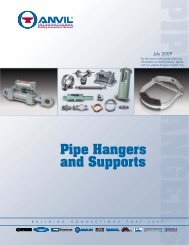Nibco Plastics Catalog - Paramount Supply
Nibco Plastics Catalog - Paramount Supply
Nibco Plastics Catalog - Paramount Supply
Create successful ePaper yourself
Turn your PDF publications into a flip-book with our unique Google optimized e-Paper software.
AHEAD OF THE FLOW ®<br />
NIBCO INC. WORLD HEADQUARTERS 1516 MIDDLEBURY ST. ELKHART, IN 46516-4740 USA PH: 1.800.234.0227<br />
TECH SERVICES PH: 1.888.446.4226 FAX: 1.888.336.4226 INTERNATIONAL OFFICE PH: +1.574.295.3327 FAX: +1.574.295.3455<br />
www.nibco.com<br />
www.nibco.com<br />
Revised 9/10/2009<br />
Solvent Welding Instructions for ABS, PVC, & CPVC-CTS<br />
Pressure & DWV Piping Systems (continued)<br />
CLEANING<br />
Using a clean, dry cotton rag, wipe away all loose dirt and<br />
moisture from the I.D. and O.D. of the pipe/tube end and the<br />
I.D. of the fitting. DO NOT ATTEMPT TO SOLVENT-WELD WET<br />
SURFACES.<br />
DANGER: Solvent cements and primers are extremely flammable<br />
and harmful if swallowed. Vapors are harmful. May<br />
cause eye irritation and repeated or prolonged skin contact<br />
causes skin irritation.<br />
Keep away from heat, sparks and open flame. Use only with<br />
adequate ventilation. Avoid contact with eyes, skin, and clothing.<br />
Avoid prolonged breathing of vapor. Close container after<br />
each use.<br />
FIRST AID: In case of skin contact, flush with water; for eyes,<br />
flush with water for at least 15 minutes and seek medical attention.<br />
Wash contaminated clothing before reuse. If swallowed,<br />
DO NOT INDUCE VOMITING, call a Physician immediately.<br />
PRIMING<br />
The function of purple primer is to penetrate and soften the<br />
bonding surfaces of PVC and CPVC pipe/tube and fittings.<br />
(Primer is not required with ABS.) It is a product that penetrates<br />
rapidly. It is very effective on the hard-finished, high-gloss<br />
products now being produced.<br />
Apply primer to the pipe/tube with a paint brush approximately<br />
1/2 of the pipe/tube diameter. A rag is not recommended as<br />
repeated contact with skin may cause irritation or blistering.<br />
Apply primer freely in<br />
the socket, keeping<br />
surface and applicator<br />
wet and in motion 5<br />
to 15 seconds. Redip<br />
applicator as necessary.<br />
Avoid puddling in<br />
the socket.<br />
Apply again to the fitting socket. The second application is<br />
especially recommended for belled-end pipe and fittings fabricated<br />
from pipe stock, for many of them have especially hard<br />
inside-surfaces.<br />
For checking penetration, you should be able to scratch<br />
or scrape a few thousandths of an inch of the primed<br />
surfaces away. Repeated application to either or both<br />
surfaces may be necessary. Weather conditions affect priming<br />
action. In cold weather more time is required for proper<br />
penetration.<br />
NOTE: The pipe/tube ends can be rested on notched boards to<br />
keep them clean and for ease of solvent cement application.<br />
Note: There are “one-step” cements available for CPVC<br />
that eliminate the need to use a primer. Cements approved<br />
for use with FlowGuard ® Gold CPVC will produce pressure-tight<br />
joints when used with NIBCO CPVC pipe and<br />
fittings. NIBCO recommends that the use of “one-step”<br />
cements be limited to applications where established<br />
temperatures are 40°F or higher, following the cement manufacturer’s<br />
instructions.<br />
SOLVENT CEMENT APPLICATION<br />
Using the proper applicator (see chart - page 158 for specific<br />
recommendations) proceed as follows:<br />
1. Apply a full even<br />
layer of cement on<br />
the pipe O.D. for a<br />
distance slightly<br />
greater than the<br />
depth of the socket<br />
of the fitting.<br />
2. Coat the fitting<br />
socket with a medium<br />
layer, avoiding<br />
puddling. On belled-<br />
end pipe or fabricated<br />
fittings, do<br />
not coat beyond<br />
the socket depth<br />
or allow cement to<br />
run beyond the bell.<br />
3. Put a second full even layer on the pipe/tube O.D.<br />
Cement Layers must be without voids and sufficient to<br />
fill any gap in the joints.<br />
79



